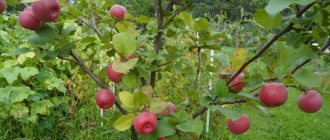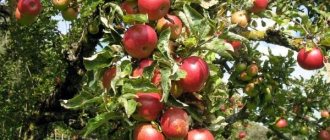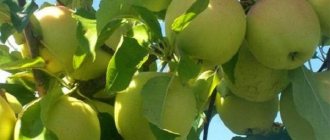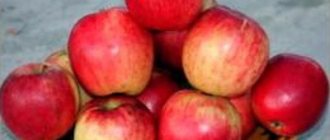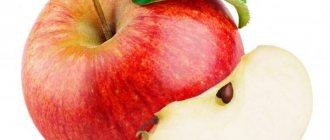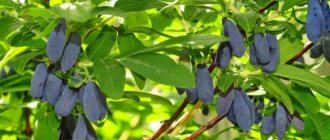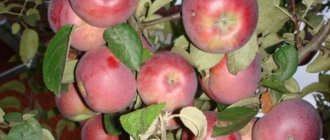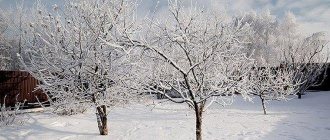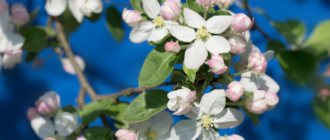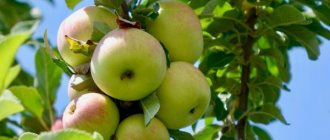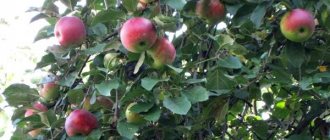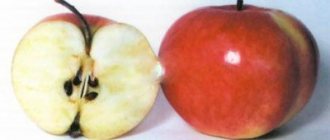The late-winter ripening apple tree “Antey” was bred by the famous Belarusian breeder Grigory Kondratievich Kovalenko, the author of many modern varieties of the crop, for example, “Kovalenkovskoye”, “Imant”, “Alesya”, “Belorusskoye Raspberry”, “Verbnoye” and others, which have earned great popularity among domestic gardeners.
Apples of the Antey variety (pictured) are round-conical, slightly flattened, densely covered with a dark red blush
“Antey” is considered especially valuable in terms of productivity and quality of fruits, and has many advantages, which we will discuss in detail later in the article. We present the main characteristics in the table:
| Parameter | Characteristic |
| Culture | Apple tree (Malus domestica Borch.) |
| Variety | "Antey" |
| Tree height | Medium height - about 2.5 m |
| Precociousness | High – begins to bear fruit in the 2-4th year after planting |
| Terms of removable (technical) maturity | Mid September |
| Period of consumption/shelf life of fruits | Late winter – apples reach consumer maturity in December; in the refrigerator they retain commercial and consumer qualities for 6-7 months |
| Type of fruiting | Mixed - on all types of fruit formations |
| Productivity of an adult tree | High – 48-62 kg |
| Size and weight of fruits | Large – 160-210 g |
| Shape and color | The apples are round-conical, slightly flattened, with wide, smoothed ribs along the entire height. The skin is of medium thickness, dense, smooth, slightly oily, covered with a bluish waxy coating. The main color is yellow-green, the cover color is in the form of a dark red blurred blush with burgundy strokes almost over the entire surface |
| Fruit pulp | Light cream with a greenish tint, medium density, fine-grained, juicy |
| Tasting assessment (taste qualities) | 4.1-4.3 points (out of 5), taste – sweet and sour, pleasant |
| Purpose of fruits | Universal – suitable for fresh consumption and all types of processing |
| Sustainability | Frost resistance is high (tolerates even harsh winters well); resistance to scab is average, to powdery mildew – above average, to fruit rot – below average |
| Year of inclusion in the State Register of the Russian Federation | 2000 |
| Recommended growing regions | Northwestern, Central |
| Year of registration in the State Register of Belarus | 1996 |
| Recommended growing areas | Brest, Vitebsk, Gomel, Grodno, Mogilev, Minsk (throughout the territory) |
| Originator | RNPD Unitary Enterprise "Institute of Fruit Growing" (Belarus) |
Rules for planting the Antey apple tree
There are no separate rules for planting and care for the Antey apple tree. They are the same as for other types
It is important to monitor them, because the acquisition of healthy seedlings is only half of the successful cultivation of fruit crops, and the rest depends on the rooting process and the conditions created for development
To properly plan planting, calculate the optimal time for seedlings. Experts recommend planting seedlings that are too young in the spring, all others (over two years old) in the fall. According to scientists, spring planting is recommended for more summer and autumn varieties of fruit trees that need some time to adapt to winter conditions.
It is believed that in the warm season, seedlings will strengthen the root system and increase the first growths, allowing them to fully survive the winter. The only drawback of spring planting is the risk of death in the hot summer. As a result, the tree needs frequent watering and drainage.
Important! To prevent apples from rotting in the basement, use phosphorus on the crown a month and a half before harvesting. Planting begins when the daytime temperature rises to 14-15 °C, and the ground is already sufficiently warmed up
Over the past twenty years, the best period has been April. Winter varieties easily adapt to new conditions during autumn planting. The main thing in this case is that the plant takes root several weeks before the first frost.
Planting begins when the daytime temperature rises to 14-15 °C, and the ground is already sufficiently warmed up. Over the past twenty years, the best period has been April. Winter varieties easily adapt to new conditions during autumn planting. The main thing in this case is that the plant takes root several weeks before the first frost.
In this case, the tree does not need to regularly moisten the soil, which does not threaten excessive dryness of the roots. On moist soil, the apple will gradually increase the number of root shoots, and with an increase in daytime temperatures it will begin to develop rapidly. Considering the characteristics of the temperate climate zone, the second half of October is the best season for growing Antey apples.
Choosing a suitable location
For the further development of the Antey apple tree, the most important things are lighting, the location of groundwater and soil characteristics. The ideal flow of groundwater is 2 m from the surface layer.
An apple tree should not be planted:
- on a hill where it will always be exposed to direct sunlight;
- in holes and ravines where cold air collects;
- in places where there is a north wind.
Remember that Antey has average pathogenic immunization. So you shouldn’t experiment with nutrition in unfavorable conditions. In a humid environment, the tree is at risk of fungal infections, which can lead to death.
Step-by-step instructions for landing
The pit for planting the Antey seedling must be prepared a month before the planned planting, and in the case of spring rooting - in the fall. The size should correspond to the root system, usually it measures 70 cm in depth and 90 cm in diameter. Then prepare a special soil mixture of equal parts peat, humus, compost and topsoil.
The bottom of the pit must be covered with clay, and the upper part must be sprayed with substrate. After this, the pit is covered with film and left in this condition until planting. For complete rooting, you should follow the advice of experts:
- before starting work, check the seedlings, remove dry and damaged parts,
- immerse the tree roots for 12 hours in a container of water that is suitable for adding a growth stimulant,
- after treatment, treat the roots with clay mash,
- insert the seedlings into the prepared hole and align the roots.
It is recommended to shake the trunk several times so that the soil fills the empty spaces between the roots.
cover the tree with soil.
Important! The root collar of the planted tree should be raised above the ground by 4-5 cm. Plan the landing site for “Antey” in such a way that the distance between the rows of trees is 4 m, and between the seedlings themselves – 1.5 m
Plan the landing site for "Antey" in such a way that the distance between the rows of trees is 4 m, and between the seedlings themselves - 1.5 m.
Portability and storage
The fruit of the hybrid is covered with a hard elastic skin, which makes transportation easier - in this case the flesh is practically not damaged. Like all winter apples, they must be collected carefully and under no circumstances should they be picked so that they do not fall to the ground. A simple stick with a cut-off plastic bottle at the end will help you collect an excellent harvest. This primitive method allows the fruits to remain intact.
During transportation, fruits are best placed in wooden or plastic boxes. To ensure maximum safety of the harvest, fruits can be packed in paper. But this is not necessary, because “Antey” is characterized by good transport tolerance.
After harvesting, boxes of apples are sent to the basement for storage. It is important that the fruits remain dry, because when wet they will not last long. Under no circumstances should fruits be treated with alcohol or other disinfectants. This will cause the fruit to lose its natural protection. It is this that protects the apple from the penetration of pathogenic microorganisms.
Winter resistance
The genetic properties of the ancestors and the conditions of hybridization have already determined the high winter resistance of the variety. The hybrid can also be grown in regions where temperatures can drop to 30 degrees below zero every winter. Cold and high humidity are not Antaeus' enemies. Therefore, the tree will bear fruit in all climatic latitudes. In addition, the apple tolerates spring frosts.
Important! Before sowing apple tree seedlings, it is advisable to treat the rhizomes with phytohormones. This procedure will stimulate the active development of the root system and rapid rooting.
Diseases and pests
Many people grow the variety solely for economic reasons - it does not require large expenses, the trees are easy to care for, and the variety quickly pays for all investments. In winter, “Antey” will be an excellent vitamin dessert. Apples store well and, under favorable conditions, can last until May without loss of color or taste.
Important! When purchasing seedlings, the roots and trunk are carefully examined. There should be no mechanical damage, mold or rotting areas. Ideally, the choice should fall on a tree with a healthy strong root, a strong and smooth trunk and 5 branches.
Average mold resistance is the weak point of the Antey variety. The tree is quickly attacked by harmful insects, so early preventative treatment is always required. In addition, in soil where there is little calcium, the roots of the tree are often subject to infection. The development of the disease can be determined by sharply rotting fruits.
Maria S.
– After planting apple trees, we must immediately monitor their health. A quick response can prevent the spread of disease or pest, which can save our little garden. After symptoms appear, I usually immediately run to the nearest garden store and take everything I have. Most often you have to deal with powdery mildew and brown rot. You immediately need to stock up on anti-aphids - they consume everything in their path, from bark to apple seeds.
Origin of the variety
In the climatic conditions of Belarus, the cultivation of many cultivated varieties of apple trees is complicated due to such a common disease as scab. That is why breeders were tasked with creating new varieties that are resistant to climate, high humidity and fungal diseases. In 1999, specialists (G. Kovalenko, V. Evdokimenko, D. Grakovich, G. Marudo) of the Institute of Fruit Growing presented the “Imant” apple tree for consideration and testing.
In the photo - apple trees "Antey" (left) and "Liberty" (right), which served as the original parent forms
To breed it, scientists crossed the famous Belarusian “Antey” and the American “Liberty”. The first was used as a cultivar, which has special value in terms of productivity and economic properties. From the second, the hybrid inherited excellent taste, immunity to scab (Vf gene) and resistance to low temperatures.
Official entry into the state register of Belarus occurred in 2005. In a short time, the variety became widely known not only in the country, but also abroad, and in 2010 it was included in the State Register of the Russian Federation. Unfortunately, due to insufficient frost resistance, this apple tree cannot be grown in some regions of Russia, for example, in the Urals, Siberia and the Far East. However, the plant produces a stable harvest in the Volga region, Moscow region and the Black Sea region.
Growing in different regions
In the Moscow region and Leningrad region
The natural conditions of the Moscow region and Leningrad region are favorable for growing fruit trees, including apple trees of the Antey variety , which have increased frost resistance.
Important! There are no special conditions for growing in these regions; you must be guided by the basic requirements for planting and growing conditions.
In Ukraine
The climate in Ukraine excludes the possibility of a period of rain and severe frosts, so this variety of apple tree can be safely grown without resorting to any tricks , but be guided solely by the general requirements for caring for the tree.
Fruiting of the Antey apple tree in Ukraine.
In Belarus
This variety was bred precisely in this region, so there are no special cultivation requirements for the Republic of Belarus.
Description of the species
The description of the type of apple tree includes technical characteristics. For example, winter hardiness, immunity to disease and pollination.
Pollination
Despite the fact that Anise does not require pollinating plants in the neighborhood, pollination can be increased if the following varieties are planted nearby:
- Borovinka;
- Bellefleur Chinese;
- July Chernenko.
The distance between apple trees should not be less than 4 m.
Taste and appearance of the fruit
Apples weighing up to 100 g. The pulp is juicy, sweet, with a slight sour taste. The peel is thin, red in color with rich scarlet stripes. Anise apple is very aromatic and tasty.
Lifespan of a tree
Anise's lifespan is about 40 years. Unlike most varieties of apple trees, the peak yield of Anise begins after 20 years of life.
Optimal landing area
The hybrid grows best in the Volga region. Many varieties are grown in Saratov, Penza, Astrakhan and Volgograd. But the hybrid is also suitable for other regions.
Reviews from gardeners
Evgeniya, 45 years old, Vitebsk
We all plant Antaeus, and these apples are also very often found on sale. What is important when you have a small area is that the tree does not take up much space and does not grow much in height. I have a 7-year-old apple tree, 2 meters tall, not taller. Convenient to harvest. And this despite the fact that I only do sanitary pruning. In general, fuss with it as little as possible; there are always plenty of apples. What else do you need?
Alexey, 60 years old, Moscow region
The apples are very tasty and juicy; they remain in the cellar until May. Beautiful to look at, children eat them with pleasure. We consistently collect 50 kilograms from each tree every year. And even if the summer is not successful, and other apple trees bear little fruit, Antey is always on top. I recommend it to everyone I know.
Elena, 53 years old, Mogilev
I planted 3 trees to grow apples for sale. They are compact, do not grow, and tolerate frost well. The variety is very successful, the apples are tasty and beautiful. They are in stable demand on the market.
Apple tree Antey variety description - Summer resident's guide
Antaeus is an apple variety whose fruits have a distinct color: from dark pink to red. Belongs to the winter varietal category.
The positive characteristics that distinguish the Antey apple variety are its remarkable taste, the weight of the fruit and the ability to be stored for a long time without losing the elasticity of the peel and the initial juiciness of the pulp - the appearance of the fruit remains unchanged, as if it had just been picked from the tree.
Apple tree Antey: description of the variety, planting and care
The high productivity and unpretentiousness of the Antey apple tree have made it famous among gardeners in many countries, especially Russia. This variety, in addition to the above advantages, has many others, which we will consider in this article.
Characteristics, description and features of the variety
The selection of the Antey variety was carried out by a Belarusian employee of the NNI, Kovalenko G.K.
when crossing the Belarusian raspberry apple tree variety and the hybrid obtained in the process of crossing Babushkino and Newtosh.
The apple tree was included in the state register of fruit tree varieties in Belarus in 1996 as a very productive and valuable crop. Apple tree Antey has the following characteristics:
| Size, height | Medium tall, height is 2.5 meters. | Large, weighing from 200 to 300 grams. | The shoots have an average thickness | Large leaves. Attachment to shoots is made by long petioles. |
| Form | Round or maybe pyramidal | Round-conical, with faint ribbing. | The cross-section of the shoots is round or slightly faceted. | Oval, slightly oblong in shape. The base of the leaf is rounded, and its tip is slightly sharp |
| Structure | The crown is sparse | |||
| Color | The branches and trunk are light brown. | The main color is green with a red or even burgundy blurred top coat. There is a waxy coating that gives a bluish tint. The pulp has a light greenish tint. | Dark brown | Dark green color. |
| Taste | Sweet with pleasant sourness and good aroma. The apple is juicy. |
Each variety has its own characteristics, which influence the choice of apple tree for your garden. Antey's features include:
- Fruiting of the apple tree is predominantly ringed.
- Fruiting begins in the second or third year after planting.
- Antaeus bears fruit regularly, which allows harvesting even in the most unfavorable years, when the yield of other trees is significantly reduced.
- The average yield of one apple tree is 50–60 kg. Provided good care and suitable terrain for growth.
- This variety tolerates even the most severe frosts, which is why it has become widespread in many regions of Russia.
- Disadvantages include poor resistance to fungal diseases, especially scab.
- The Antey variety apple tree is a winter variety. Harvesting begins at the end of September and continues until the beginning of October.
- Final maturity occurs after about two months of laying.
- The shelf life of Antea fruits lasts until mid-spring, while maintaining their taste and beneficial qualities.
Due to its composition, the fruits are useful in the process of medical therapy, for restoring the body from diseases or vitamin deficiency.
Planting and care
Antey apple trees do not differ in planting technology from other fruit trees.
Tree planting is recommended to be done in autumn or spring.
In the spring, planting is carried out before the buds open, in the fall after the leaves fall.
Let's consider the basic planting technology for fruit trees:
The first stage of planting is choosing a suitable area and preparing the hole. When performing this stage, the following criteria must be taken into account:
- The place for the tree should be well lit and protected from the wind.
- Trees should not be planted in low-lying areas to prevent them from becoming waterlogged.
- Make sure that the groundwater level is low; if it is close, it is necessary to prepare a hole using a special technology in order to best protect the root system of the apple tree from waterlogging.
- Preparation of the hole should be carried out at least a month before planting, this includes: digging the hole;
- laying a drainage system;
- fertilizing the soil with organic or mineral fertilizers. You can use them in combination;
- in the case of close proximity to groundwater, a barrel without a bottom is dug into the ground, instead of which a drainage cushion consisting of sand, soil and peat is laid.
What type does it belong to?
Antey is a winter variety. Apples can be stored in a cool, well-ventilated area for 5-6 months.
At the same time, they do not dry out due to the dense skin and pulp, and for the same reason they do not suffer during transportation.
The tree itself is no less hardy, producing such long-lasting and strong fruits.
In 1996, Antey was included in the State Register of Varieties and Tree and Handicraft Species of Belarus for its hardiness and abundant fruiting.
Antey is a winter-hardy variety and is able to grow and bear fruit safely in regions of Russia where in winter the temperature drops below thirty degrees.
Winter varieties also include: Idared, Golden Delicious, Granny Smith, Aport and Antonovka vulgaris.
History of selection
The winter apple tree “Antey” is a gift from specialists from the Belarusian Research Institute to domestic gardeners. Breeders dreamed of creating a large-fruited, productive apple tree with increased resistance to cold climatic conditions.
The ancestors of the variety are apple cuttings “Newtosh” and “Babushkino”. The hybrid that grew from them was later crossed with the “Belarusian Raspberry”. During the process of hybridization, the apple tree was tested by harsh winters and lack of basic care.
Botanists deliberately stripped the apple tree of all this to test its true viability.
Did you know? In Europe, the largest exporter of apples is Poland, and on a global scale, the People's Republic of China takes the lead.
As a result of painstaking work and long improvements, a new variety was developed, the main advantages of which include frost resistance, stable yield, excellent taste and marketability of fruits, and super-keeping quality.
More than 20 years ago, for such a positive description of the variety, the Antey apple tree was included in the State Register of Tree and Handicraft Varieties of Belarus as especially valuable and productive.
Disease and pest control
The Antey variety is at risk of scab , especially if the summer is rainy. This fungal disease causes damage to leaves and fruits, and fungicides (Fitosporin, Gamair, Strobi, etc.) can help fight it.
Find out more about the fight against scab on apple trees.
Harmful insects (aphids, sawflies, codling moths, leaf rollers, flower beetles, weevils, hawthorns, silkworms) are destroyed using traps, catching belts, insecticides (Bordeaux liquid, Decis, Fitoverm, Confidor, etc.). A prerequisite is preventive treatment of trees against pests and diseases , which should be carried out in the spring.
Landing
Seedlings should be planted in early spring, even before active bud bloom. They can also be planted in the fall. This is done after the end of leaf fall. Some experts recommend planting this variety in the fall, when frosts have not yet begun. Their recommendation is based on the fact that after autumn planting the tree will have more time to develop. In the spring months, this period decreases, since at this time the tree directs all its efforts to budding and trunk growth, and not to the development of roots.
Seedlings should be planted in areas where there is no high groundwater. It is recommended to do this on fertile or well-fertilized soil. The place should be well lit. The apple tree will not grow well if acidic soil is chosen for planting it.
This is useful to know: before planting, seedlings should be placed in a container filled with water for some time. This is done so that the roots are properly saturated.
Pollination
Most apple trees are self-fertile ; to bear fruit they require trees with which cross-pollination is possible.
Antey is no exception , so it is recommended to plant it next to other varieties with an average flowering period.
These can be almost any autumn or summer varieties - of which the best are: Welsey, Anise, Autumn Striped, Saffron Pepin. Winter varieties do not pollinate well with each other.
Summer varieties Zolotoe Letneye, Doch Papirovka, Yandykovsky, Orlovim and Dachny can be used as pollinators.
Red early apple tree: variety description and characteristics
Red early apple tree: photo of variety
The culture was bred in 1965 by crossing two varieties: the Vesna variety and the Melba variety. The experiment was successful, and as a result, this variety of apple tree was developed, which was called Red Early. At first, the variety was not widely used because the tree had low resistance to winter. However, in those regions characterized by a mild climate, the tree grew quite well.
In addition, the plant has a small fruit size, both the trunk and the crown as a whole. However, the taste of apples is so good that those who have tried these apples no longer pay any attention to the size. It is the taste properties of the apple that attract all gardeners, as a result of which the apple tree is in great demand in completely different regions of the country.
The Red Early apple tree variety is a summer variety, so the harvest here begins in mid-July.
The plant was bred at the Institute of Horticulture named after I.V. Michurin. Experienced scientific breeders worked on the hybrid. The variety was bred with a recommendation for cultivation in the Central Black Earth region.
The advantages of the plant include self-pollination, so pollinators are not needed for good fruiting. After 3-4 years, the tree begins to bear its first fruits. The harvest ripens annually, only severe weather conditions can negatively affect the harvest.
Advantages and disadvantages of the variety
The advantages of the Red Early apple tree variety include the very beautiful appearance of the fruit. They are not only consumed fresh, but also used for decorative purposes. Along with their beautiful appearance, apples have high taste properties. Moreover, they ripen already in mid-summer or at the end. The plant has very good resistance to hot, dry summers, so it can be grown in areas with a hot climate.
The disadvantages of the Red Early apple tree include the shrinking of the fruits as the tree ages. In addition, ripe fruits may fall off and spoil. It is recommended to harvest as soon as the fruits are ripe. You can do this in several approaches. In addition, the disadvantage is the short shelf life of the fruit. It is only 30 days, provided that the apples are stored in a cool, dark place. However, the fruits do not tolerate long-distance transportation well.
Plant characteristics
The height of the Red Early apple tree can reach about 5 meters, so caring for the tree and harvesting it will not be difficult. The crown has a rounded shape when it comes to a young plant. An adult tree has a fairly spreading and wide crown, depending on its formation. It is recommended to begin forming a crown immediately after planting the tree, otherwise it will be too spreading and thick.
Fruiting
After the tree is already 4 or 5 years old, the first fruits can be harvested. The harvest ripens stably and regularly, without any interruptions. One tree can bear about 30 kg of fruit, provided that the tree is already 7 years old. Experts rate the taste properties of apples at 4.45 points, and the appearance of apples at 4.5 points. These are practically the highest ratings, so we can conclude that the fruits are very attractive and tasty.
Speaking about the winter hardiness of the Red Early apple tree, as described above, it has average resistance to frost. During the cold season, the apple tree may freeze slightly.
Among the popular diseases, the early Red apple tree is often affected by powdery mildew, scab, fruit rot, cancer and other common diseases. Pests include aphids, leaf rollers, moths and moths.
additional characteristics
Advantages and disadvantages
The positive properties of this variety include the following:
- Long shelf life of fresh fruits;
- High frost resistance;
- Regular fruiting.
The main disadvantage is that it is affected by scab.
The Antey apple tree is prone to scab.
Dimensions
The tree is medium-sized up to 3 meters in height . The crown is sparse, pyramidal-rounded, divided into tiers, up to 3 meters in diameter .
Productivity
The productivity of the variety is high . One mature tree can produce up to 50 kg of fruit.
Tasting assessment
The fruits have a sweet and sour taste and are high in nutrients. Apples contain:
- Dry matter – up to 13.0%;
- Titrated acid – up to 0.65%;
- Sugars – up to 10.0%;
- Ascorbic acid – up to 21 mg per 100 grams of fruit;
- Carbohydrates – up to 9.0%;
- Proteins – up to 0.4%;
- Pectin – up to 12%;
- P-active substances – up to 370 mg per 100 grams of fruit.
Winter hardiness
Winter hardiness is high . The tree is able to withstand temperatures below minus 30 C without negative consequences for further development.
Disease resistance
The apple tree is moderately resistant to pests. Affected by scab.
Lifespan of a tree
The lifespan of a tree is 30-35 years , of which the active period is from 5 to 25 years of development.
Antey actively bears fruit from 5 to 25 years of age.
Zoning
This variety was bred by breeders of the Republic of Belarus at the end of the twentieth century. Due to its frost resistance, the variety is grown in all regions of our country.
Look at the video description of the Antey apple tree:
Selection of seedlings
Healthy seedlings are suitable for planting
You can buy planting material at a gardening nursery. Choose mature apple trees 2-3 years old with closed roots (in an earthen coma or in a plastic container). Such trees are protected from drying out and have almost 100% survival rate.
When purchasing, carefully inspect the crown - a healthy plant does not have mechanical injuries, mold, growths, sagging, rot or spots of unnatural color. The leaves and buds are fresh, green, and do not fall off.
Before planting, apple trees are dipped in cold water with the addition of a growth stimulant to saturate the rhizome with moisture. After this, it is treated with a clay mash.
Why are there no apples?
- Cold period during flowering. If bees do not fly, pollination does not occur and fruit does not set.
- Lack of lighting. In the shade, the apple tree sets fruit very poorly; they grow small and there are few of them.
I myself have never grown Antaeus, but my neighbors grow it. The tree bears fruit every year. If my apple trees bear fruit every year, then Antey annually pleases my neighbors with delicious apples. I also plan to plant this apple tree soon. I'll soon have room for this.
Vitaly, Nizhny Novgorod
But I don’t really like Antey. It is prone to infection with scab and some fungal diseases. It has to be constantly processed. I don’t like the color of the fruit either; there are more beautiful apples in my garden. I sell my apples at the market, but due to its not very attractive appearance, Antey sells poorly. There are nicer apples in my orchard that sell much better.
Veronica, Ryazan
I'm delighted - apples appear every year! No need to think that they are tasteless. The fact is that they acquire their real taste only after two months of storage. We always have a lot of apples. We make jam and compotes from Antey, leave the apples to sit, and still we have extra fruits that we share with our neighbors.
READ MORE: Bayan apple tree variety description, characteristics and cultivation with photos
Marina, Usklyai
I love Antey very much. This is an amazing variety! Apples appear every year and in large quantities. I do not recommend eating them straight from the branch; the apple should sit for a while, and then it will become full of real flavor.
Sergey, Ufa
Features of seasonal care
During the growing season, the apple tree requires nutrients, moderate amounts of water, crown adjustments and soil care.
Abundance of watering
Young seedlings need to be watered much more often than mature apple trees. Plan the first watering in the spring before the buds open and then repeat moistening the soil after 2-3 weeks. The second watering for adult plants is done when they fade, as well as during the growth period of greenfinches. It is advisable to carry out the last water procedure several weeks before harvesting.
The rate of water poured under each tree depends on its age: 2 buckets are enough for one-year-old seedlings, 3-4 buckets for two-year-old seedlings, and 6 to 10 buckets for older ones.
The role of mulch
Each watering should end with cultivating the soil in tree trunk circles
It is important to loosen it in time and clear it of weeds. To prevent moisture from evaporating and weeds from growing, experienced owners lay hay or other mulch under the trees. In this case, it is important to retreat 10-15 cm from the trunks
Otherwise, microorganisms that appear in the decomposing material will easily penetrate the roots of the tree, which, at best, will lead to its diseases.
In this case, it is important to retreat 10-15 cm from the trunks. Otherwise, microorganisms that appear in the decomposing material will easily penetrate the roots of the tree, which, at best, will lead to its diseases. With the beginning of active growth, the apple tree is watered with an infusion of chicken manure to increase green mass.
During the formation of the ovary, a solution of nitroammophoska, ammonium nitrate (1 tablespoon each), calcium chloride (1.5 tablespoons) and superphosphate (150 g) will be very useful for the tree.
With the beginning of active growth, apple trees are watered with an infusion of chicken manure to increase green mass. During the formation of the ovary, a solution of nitroammophoska, ammonium nitrate (1 tablespoon each), calcium chloride (1.5 tablespoons) and superphosphate (150 g) will be very useful for the tree.
All ingredients must be dissolved in a bucket of water. The next feeding is important at the end of summer. In order to prepare the apple tree for winter, it is advisable to fertilize it with autumn mineral complexes or a superphosphate solution (50 g per 1 liter of water).
Preventative treatment
In the case of Antey, you shouldn’t wait for the first signs of illness; it’s better to be proactive. To do this, in early spring, spray the apple tree with a solution of copper sulfate (50 g per 1 l).
An alternative to it are the following drugs: “Albit”, “Skor”, “Hom”, which must be diluted in accordance with the manufacturers’ recommendations.
Pruning and crown formation
The crown of the hybrid does not require heavy pruning, since it is not prone to intensive thickening. However, every spring, before the start of sap flow, it is necessary to remove old and disease-affected branches from the tree, clear it of competing sprouts, leaving the stronger one.
Ideally, the bottom layer of branches should consist of third-year growth; on an apple tree, all shoots should receive uniform lighting and not cast shadows on each other. The cut location is just above the third eye. When forming the crown, do not forget to rejuvenate its core.
Preparing for winter
Only young, immature seedlings need shelter for the winter. Their trunk circles are covered with mulch made from humus or compost, and the trunk and branches are wrapped in thick fabric. Mature apple trees will need to be protected from rodents.
To do this, you can hide the trunk behind a fine mesh, roofing felt or spruce branches. In just a few years, Antey apple trees will thank you for your basic care with a good harvest, from which you can make a profit if you wish.
The Antey apple tree is a winter variety characterized by excellent taste and product characteristics. Being the result of crossing a hybrid of winter varieties Babushkino and Newtosh with Belarusian Raspberry, it is distinguished by regular fruiting, good yield and high frost resistance.
Ripening and fruiting
Fruiting of the variety is one of the important features for which gardeners value Antey.
Beginning of fruiting
The first fruits can be collected even in the second year after planting a young one-year cutting.
Deadlines
The timing of harvesting and storing the fruits of the Antey variety is typical for a winter apple tree.
Maturation
Depending on the climatic conditions of the region, fruit ripening can vary from mid-September to mid-October.
Ripe apple fruits.
Fruit storage
If you store harvested fruits on time correctly, the taste of the fruits and their appearance will be preserved until April. It is only important to ensure the correct temperature, sufficient humidity and ventilation.
Features of cultivation and care
Let's get acquainted with the procedure for planting and subsequent care of the Antey variety.
Selection of location and planting material
Choose a sunny place for planting this apple tree, making sure that the soil is fertile, light in composition and neutral in acidity. Groundwater should not lie close to the surface.
It is preferable to plant trees in the fall, after the leaves have fallen and before the onset of frost, so that the trees have time to take root. Spring planting should be completed before buds appear.
We recommend reading about planting apple trees in the fall.
Seedlings should be purchased only at specialized sales points from sellers with a good reputation. Before purchasing, trees must be inspected and diseased, warped, blackened, and growth-bearing specimens are discarded.
After purchase, planting material is kept so that the roots do not dry out. Before planting, they must be immersed in water for 2–3 hours, having previously been examined to ensure there are no broken or damaged parts.
Before planting, the seedling should be placed in a container of water for several hours so that the root system is saturated with moisture.
Planting scheme
The sequence of actions when landing is as follows:
- Dig a hole about 1 m in diameter and 0.8 m deep.
- Place a drainage layer (expanded clay) on the bottom.
- Mix the excavated soil with fertilizers and pour some into the hole.
- Set up the tree, spreading out the roots.
- Fill the remaining soil with a mound, making sure that the root collar of the seedling rises 3–5 cm above the ground.
- Lightly compact the soil.
- Create a shallow ditch in a circle.
- Install a support and tie the seedling to it.
- Water the tree with 20 liters of water.
- If after some time the ground settles, add more soil.
- Water the seedling once a week.
Fig. 1 - the process of planting a seedling, Fig. 2 - a correctly planted seedling
Watering and fertilizing
An adult tree of the Antey variety should be watered three times per season:
- in early spring;
- in summer, if there has been no rain for a long time;
- in the fall, when the harvest is harvested.
1 tree will require about 80 liters of water.
Important! It is recommended to sprinkle the soil with mulch (straw, sawdust) to protect the roots from moisture loss. The fertilizer application scheme looks like this:
- in spring, after flowering;
- at the moment of fruit formation;
- in the fall, after harvesting.
In autumn, trees are fed with organic fertilizers or mineral fertilizers (phosphorus-potassium), but nitrogen fertilizing is carried out only in early spring.
Timely application of fertilizers is an important step in tree care
Pruning and crown formation
The formation of the crown is necessary not only for the beauty of the tree, but also for increasing the yield and taste of apples, since the crown becomes less thickened and allows the sun to pass through better. At the same time, the branches become more powerful and can better withstand the harvest, and the height of the tree makes it easy to remove ripe apples.
We advise you to read what you need to do with the tops that appear on the apple tree and how to prune them correctly. The Antey variety is characterized by the fact that its branches grow in tiers, so it is not difficult to form a crown:
- For a seedling that was planted in the fall, in the spring they leave 50 cm of the trunk and 30 cm for the 3 lower branches.
- After a year, 1 branch is left at a height of 50 cm and 2 - after 15 cm, which grow in the other direction. The ends of the branches are shortened.
- A year later, 2-3 branches are left in the next tier, 50 cm from last year’s, and the ends are shortened.
- After another year, 1 branch is left every 50 cm, the ends of all tiers are shortened equally. The central branches are trimmed a little.
The apple tree tolerates pruning measures calmly
The crown is formed according to the following rules:
- The branches of the 1st tier should be directed in different directions. The greater the distance between them, the better.
- Branches that grow higher should be shorter than branches that grow lower.
- Do not remove more than 1/3 of the growing branches.
- The branches of the 1st tier are cut to the same length.
- The distance between the branches of the 1st tier is maintained at 15 cm.
Pruning is necessary so that old, diseased, broken branches do not interfere with the tree’s growth. It can be carried out in early spring or after harvesting. In addition, it is necessary to prune the central shoot if the tree begins to actively stretch upward.
Did you know? US President George Washington relieved stress by pruning apple trees in his own garden.
Preparing trees for winter
After the leaves fall, sanitary pruning is carried out, all plant debris is removed, and fertilizers are applied to the tree trunk circle, combined with watering. Then the soil is loosened and sprinkled with mulch. For the winter, it is recommended to wrap the trunk of the apple tree with non-woven material (but not polyethylene) to protect it from rodents.
Productivity
Unlike a significant part of other apple varieties, Antey does not have a clearly defined cyclicity in fruiting.
It lays flower buds not every year, but every year , so even in those seasons when other apple trees practically do not produce a harvest, trees of this variety stand strewn with ripening fruits.
The number of apples on one adult plant is about 50 kilograms ; when planted according to a five by three scheme, you can achieve a yield of up to 40 tons per square hectare of garden. Due to regular and abundant fruiting, this variety is commercially valuable.
The fruits reach maturity in the second half of September or early October.
Their consumer maturity comes approximately two months after picking the apples , the tone of the peel and pulp becomes a little warmer, slightly yellowish.
From winter to mid-spring, Antey retains all its taste qualities.
Pay attention to other fruitful varieties of apple trees: Dessertny Petrova, Papirovka, Orlovskoe Polesie, Marat Busurin and Orlovskoe Polesie.
Planting: site selection and seedling preparation
The characteristics of the Antey apple tree indicate its unpretentiousness to growing conditions. However, for persistent fruiting and healthy apple trees, you must follow the following recommendations:
- choose a place for planting on flat areas with fertile soil and good air circulation, without close groundwater (minimum permissible depth - up to 2.5 m);
- plant a young garden away from old trees and shrubs that may be affected by diseases and pests;
- do not introduce fresh organic matter and mineral fertilizers into planting holes: this has a detrimental effect on the survival rate of young seedlings and prevents beneficial microorganisms and worms from developing in the root zone of trees;
- before planting in the ground, seedlings can be soaked in a solution of a root formation stimulator (Kornevin, Heteroauxin, Zircon);
- When planting and during the rooting period (from 3 to 6 weeks), the apple tree requires abundant watering (about 10 buckets of water per tree), mulching the soil with peat, straw, and sawdust.
Taking into account the growing technology, planting of fruit crops is carried out in late autumn (preferably) or early spring. Scheme for placement of seedlings: 5×3 – for dwarf rootstocks, 0.5×1 – for medium-sized ones. The depth of the planting hole is up to 70 cm.
Since the variety is self-fertile, it requires cross-pollination. The best pollinators for Antey are autumn and summer varieties of apple trees with medium or medium-early flowering: Anise, Pepin saffron, Autumn striped, Welsey.
Subspecies and options
On a dwarf rootstock
To reduce labor costs when growing trees and harvesting, an increasing number of breeders are growing apple trees on dwarf rootstock. The Antey variety is no exception.
One of the types of rootstock when grown in this way is rootstock 62-396.
After planting, the central conductor is shortened, its length should be 40 cm, the side shoots are cut so that their length is 15-18 cm, they are bent to create wide angles in relation to the central conductor.
Otherwise, the cultivation is the same as for the usual method of forming a tree.
In the video below you can see the Antey apple tree on a dwarf rootstock:
Columnar variety
The Antey apple tree can also be grown in a columnar form - when the branches of the tree grow upward and the crown is small. The properties inherent in the variety remain unchanged.
Trimming
Tree pruning can be done in both the spring and autumn months. In the spring, branches that have not survived the winter should be removed, but the main pruning is still done in the fall. At this time, the apple tree is sanitary cleaned, it is freed from everything unnecessary. Pruning is done on a bare apple tree, when the entire harvest has been harvested and the leaves have fallen.
Remember that care must be taken when removing shoots, as excessive removal can have a negative impact on the development of the plant. The number of branches removed should not exceed 1/3 of the total volume. The crown must be formed in compliance with certain rules:
- The arrangement of skeletal branches should not be crowded; the farther they are from each other, the better.
- Skeletal branches should not be larger than the central shoot.
- The upper branches should be smaller than the lower ones.
Apple trees are pruned in the spring, in March-May. The plant needs regular removal of dead branches and tops, which are breeding grounds for fungus. In hot weather, the plant should be provided with watering at the rate of 50-80 liters per tree.
Regular feeding of the plant can ensure high-quality growth and good fruiting. The formation of flower buds will be ensured by preparations containing phosphorus and nitrogen, both mineral and organic (bird droppings). Fertilizing should be done after the end of flowering, with the beginning of fruit ripening, and also in August-September - to maintain the growth of the root system. If the soil is poor, it must be fertilized annually. For a denser and fattier substrate, fertilizing can be done once every 3 years.
